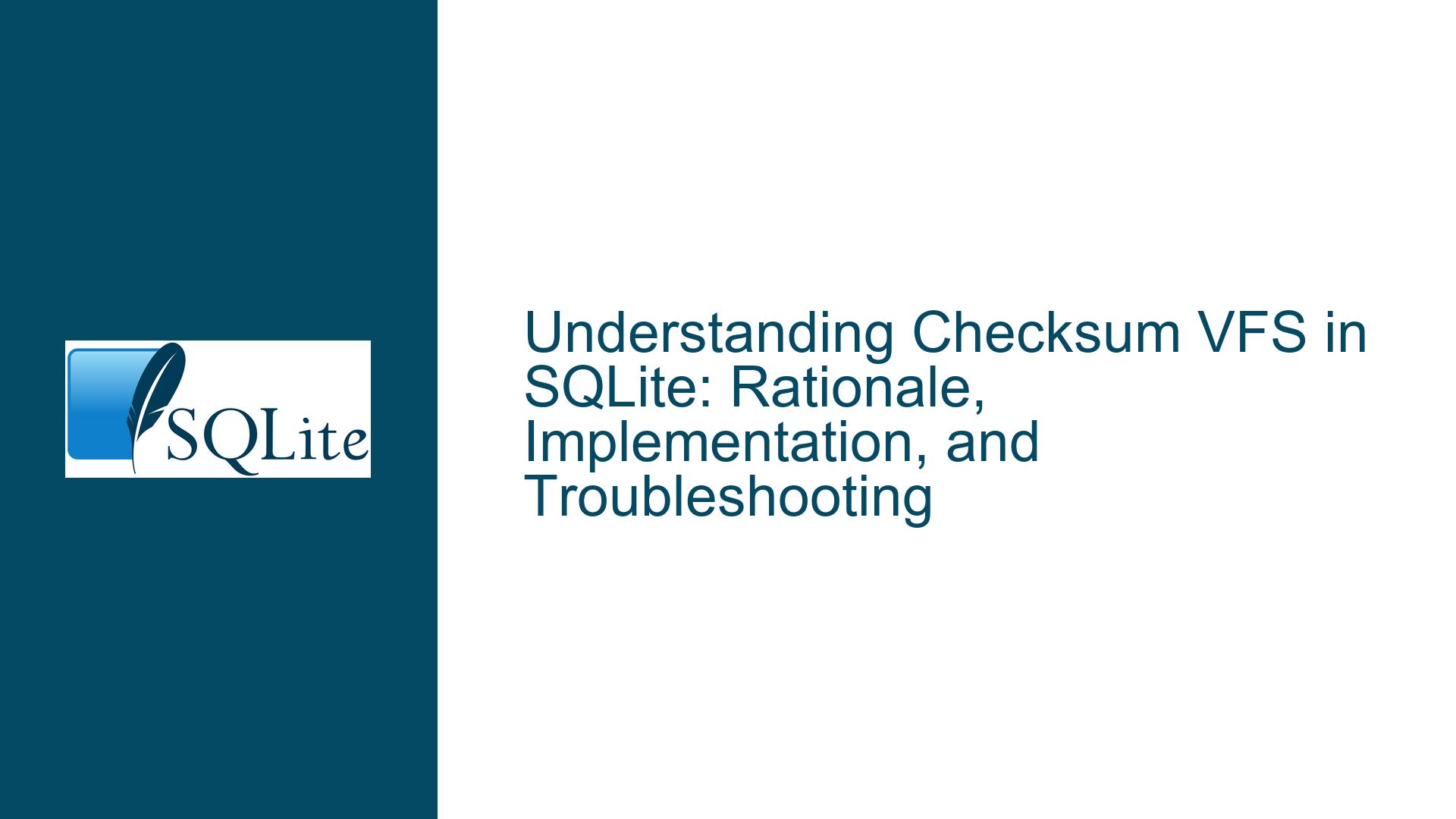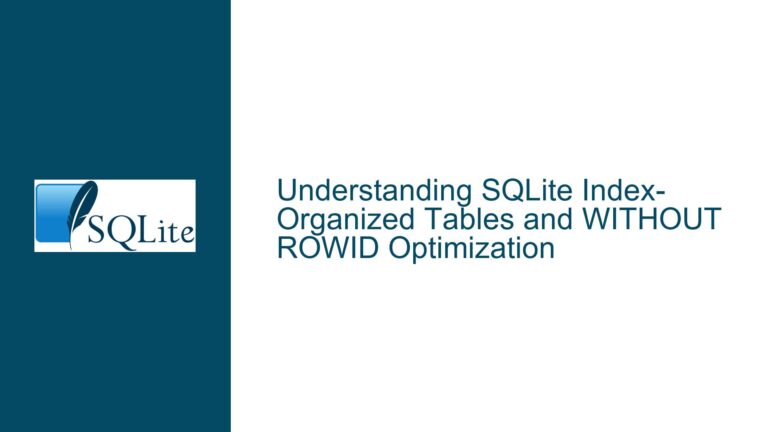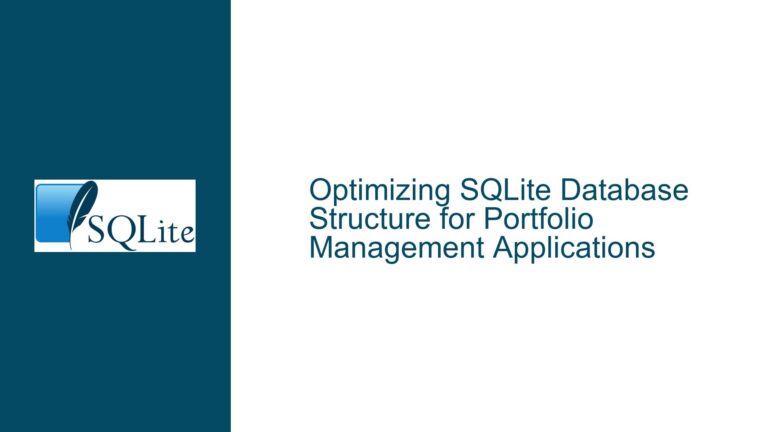Checksum VFS in SQLite: Rationale, Implementation, and Troubleshooting
Checksum VFS: Rationale and Functionality in SQLite
The Checksum VFS (Virtual File System) in SQLite is a specialized layer designed to enhance data integrity by introducing checksums for database pages. This mechanism is particularly relevant when dealing with the Write-Ahead Logging (WAL) mode, which is a common configuration for improving concurrency and performance in SQLite databases. The primary purpose of the Checksum VFS is to ensure that data pages written to the WAL are protected against corruption, even in scenarios where the system might experience unexpected failures such as power outages or OS crashes.
The Checksum VFS operates by embedding checksums into the pages as they are written to the WAL. These checksums are then verified when the pages are read back, ensuring that the data has not been corrupted during the write process. However, an interesting design choice is that these checksums are disabled during the checkpointing process. Checkpointing is the mechanism by which the contents of the WAL are transferred back to the main database file, ensuring that the database remains consistent and up-to-date.
The rationale behind this design is multifaceted. First, the WAL itself is already protected by multiple checksums, which provide a high degree of confidence that the data within the WAL is not corrupted. Second, the Checksum VFS is designed to work in conjunction with the WAL to provide an additional layer of protection, particularly during the write process. By checksumming the pages as they are written to the WAL, the Checksum VFS ensures that any corruption that might occur during the write process is detected early, before it can propagate to the main database file.
However, during checkpointing, the checksums are disabled. This is because the checkpointing process involves transferring data from the WAL to the main database file, and the checksums in the WAL are no longer necessary once the data has been successfully transferred. Disabling checksums during checkpointing can also improve performance, as it reduces the computational overhead associated with calculating and verifying checksums during this critical phase of database operation.
Potential Causes of Checksum VFS Issues
While the Checksum VFS provides a robust mechanism for ensuring data integrity, there are several potential causes of issues that can arise when using this feature. One of the primary causes is the complexity of the implementation itself. The Checksum VFS introduces additional layers of complexity to the SQLite codebase, particularly when it comes to handling the checksums during the write and checkpointing processes. This complexity can lead to subtle bugs or performance issues, particularly in environments where multiple instances of SQLite are operating concurrently.
Another potential cause of issues is the interaction between the Checksum VFS and other SQLite features, such as the Backup API. The Backup API is used to create backups of SQLite databases, and it is designed to work seamlessly with the Checksum VFS. However, if the Backup API is not used correctly, or if there are issues with the implementation of the Checksum VFS, it is possible for the checksums to be incorrectly transferred during the backup process. This can lead to data corruption or other issues when the backup is restored.
Additionally, the Checksum VFS relies on the sqlite_dbpage table-valued function to read pages from either the main database file or the WAL. This function is critical for the correct operation of the Checksum VFS, as it ensures that the checksums are verified correctly when the pages are read back. However, if there are issues with the implementation of the sqlite_dbpage function, or if it is not used correctly, it can lead to incorrect verification of checksums, which can in turn lead to data corruption or other issues.
Troubleshooting Checksum VFS: Steps, Solutions, and Fixes
When troubleshooting issues related to the Checksum VFS in SQLite, it is important to follow a systematic approach to identify and resolve the underlying causes. The first step is to verify that the Checksum VFS is being used correctly in the context of the WAL mode. This involves ensuring that the checksums are being calculated and verified correctly during the write process, and that they are being disabled correctly during the checkpointing process. This can be done by reviewing the SQLite documentation and the implementation of the Checksum VFS in the codebase.
The next step is to verify the interaction between the Checksum VFS and the Backup API. This involves ensuring that the checksums are being transferred correctly during the backup process, and that they are being verified correctly when the backup is restored. This can be done by reviewing the implementation of the Backup API and the Checksum VFS, and by testing the backup and restore process in a controlled environment.
Another important step is to verify the correct operation of the sqlite_dbpage table-valued function. This involves ensuring that the function is being used correctly to read pages from either the main database file or the WAL, and that the checksums are being verified correctly when the pages are read back. This can be done by reviewing the implementation of the sqlite_dbpage function and by testing its operation in a controlled environment.
If issues are identified during the troubleshooting process, there are several potential solutions and fixes that can be applied. One solution is to update the implementation of the Checksum VFS to address any bugs or performance issues that have been identified. This may involve modifying the code to improve the handling of checksums during the write and checkpointing processes, or to improve the interaction between the Checksum VFS and other SQLite features.
Another solution is to update the implementation of the Backup API to ensure that the checksums are being transferred correctly during the backup process. This may involve modifying the code to improve the handling of checksums during the backup and restore process, or to improve the interaction between the Backup API and the Checksum VFS.
Finally, if issues are identified with the sqlite_dbpage table-valued function, it may be necessary to update the implementation of this function to ensure that it is being used correctly to read pages from either the main database file or the WAL, and that the checksums are being verified correctly when the pages are read back. This may involve modifying the code to improve the handling of checksums during the read process, or to improve the interaction between the sqlite_dbpage function and the Checksum VFS.
In conclusion, the Checksum VFS in SQLite is a powerful tool for ensuring data integrity, particularly in environments where the WAL mode is used. However, it is important to be aware of the potential causes of issues that can arise when using this feature, and to follow a systematic approach to troubleshooting and resolving these issues. By understanding the rationale behind the Checksum VFS, identifying potential causes of issues, and applying appropriate solutions and fixes, it is possible to ensure that the Checksum VFS operates correctly and provides the intended benefits in terms of data integrity and performance.






